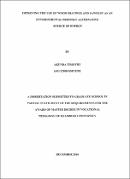| dc.description.abstract | This research project was carried out to improve the management of wood shavings and sawdust at
Civil and Building Engineering Department, Kyambogo University (CBED). The objectives of the
study were to: identify the current methods of disposing off wood shavings and sawdust at CBED,
Kyambogo University; assess the environmental safety problems facing the Department of CBE
arising from wood shavings and sawdust from Carpentry and Joinery Workshop; establish the
methods of management of wood shavings and sawdust in selected workshops in Kampala and
propose solution to problems facing the Department of CBE arising from wood shavings and sawdust
from carpentry and joinery workshops in Kyambogo University.
A survey was conducted in ten selected workshops in Kampala underpin this study in order to
establish the management of wood shavings and sawdust in Carpentry and Joinery Workshops.
Questionnaires, interview and observation were the major instruments used for data collection.
The findings of the study indicated that: Heaping of wood shavings and sawdust was the most serious
problem followed by Burning in open space, leaving to decompose and the use of closed dustbins
were the current methods being used to dispose off wood shaving and sawdust at CBED, Kyambogo
University. Littering, bad smell, skin and eye problems were among the environmental and health
problems arising from wood shavings and sawdust at Carpentry and Joinery workshop, Kyambogo
University. Selling, poultry, piggery and mulching were the methods of managing wood shavings and
sawdust used in the selected workshops in Kampala. Briquette making was proposed by the researcher
as the best proposed solutions of improving the management of wood shaving and sawdust at CBED,
Kyambogo University.
It was concluded that burning in open space was the major current method of disposing wood
shavings and sawdust; heaping and bad smell were the major environmental problem arising from
sawdust; selling wood shaving and sawdust were done by majority of workshops and briquettes
making was the best proposed solution for improving the management of wood shaving and sawdust.
It was recommended that: University management needs to embrace and support this research project
of making briquettes from wood shavings and sawdust when training students in order to minimize
the environmental degradation and health problems arising from the Carpentry and Joinery workshop
at CBED, Kyambogo University. Management further needs to put in place appropriate methods of
disposing off wood shavings and sawdust like selling, taking it to the farm to be used as feeds for
piggery and poultry in the University farm and the management need to provide Personal Protective
Equipment (PPEs) and ensure that they are properly used by the people using the Carpentry and
Joinery workshop.
Key words: wood shavings and sawdust; management; environmental degradation; healthy problems. | en_US |

